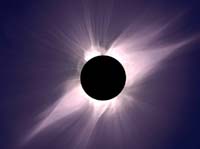|
|
Different Kinds of EclipseThere are 2 basic kinds of eclipse: solar and lunar. A solar eclipse occurs when the moon passes between the earth and sun, and casts its shadow on the earth. A lunar eclipse occurs when the earth passes between the moon and the sun, casting its shadow on the moon. Solar eclipses occur about every 18 months, and usually last a few minutes (with a maximum of 7). Lunar eclipses occur 2 weeks after a solar eclipse, but are typically visible over a much wider area. There three kinds of solar eclipse: total, annular, and partial. A total eclipse occurs when the moon completely covers the surface of the sun (from earth's perspective), and when the resulting shadow crosses the earth. The shadow is typically 10's of miles wide, and moves about 1,000 miles and hour. Outside the shadow, you will see a partial eclipse. A partial eclipse occurs when the moon occults only part of the sun. This happens both when the moon is not perfectly lined up with the earth (and thus there is no total eclipse), and outside the shadow's path during a total eclipse. Finally, an annular eclipse is precisely the same as a total eclipse, except the moon is slightly further from the earth, and the moon's shadow doesn't fall on the planet. It looks like a partial eclipse (the sun is still partially visible), except the moon is exactly in the center of the sun. During totality, it's about as bright as a midnight sky under a full moon. The major planets can be seen in the sky, and some stars if it's clear. You can look directly at the event with the naked eye; it's possible to see solar prominences without binoculars or a telescope. The shadow of the moon passes over every spot on earth approximately every 340 years. There is a total solar eclipse on earth, viewable from land, about every year and a half. |
